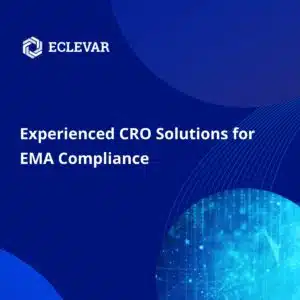What are the experienced CRO solutions available for Medical Device EMA Compliance?
European Medicines Agency is the organ responsible for the assessment of quality and safety of pharmaceutical products that are launched in Europe market, including medical devices. For acceptance and authorisation, the manufacturer must present to the board a centralised analysis of performance, following the directions of Medical Device EMA Compliance.
Each country member of Europe has its own regulation agency, but the EMA is always involved in the regulatory process. EMA has distinct responsibilities per category of medical device, including in vitro diagnostics.
Get to know more about Medical Device EMA Compliance and how Eclevar, a responsible CRO company, can help your product attend all conformities designed for market approval in Europe.
EMA compliance for the medical device industry
The European Medicines Agency is a regulatory body responsible for the scientific evaluation, supervision, and safety monitoring of medicines within the European Union (EU). Established in 1995, the EMA plays a vital role in safeguarding public health by ensuring efficacy of medications and devices available to patients across the EU member states.
EMA operates as an independent agency, collaborating closely with national regulatory authorities and other stakeholders to evaluate and authorize medical products for the European market. The Agency conducts rigorous assessments of medical devices, analysing data from clinical trials, preclinical research, and manufacturing processes.
After the assessment, the EMA provides recommendations for marketing authorization, which are then forwarded to the European Commission for final decision-making. The agency also offers scientific advice to companies during the development and research phases, aiming to streamline the approval process and enhance the quality of submitted data.
CE (Conformité Européenne)
EMA and the CE are both regulatory systems related to medical products, but they serve different purposes and apply to different types of products. While EMA is responsible for the regulation of pharmaceutical products, CE mark is applicable to a broader range of medical devices and indicates compliance with EU directives or regulations.
Manufacturers can place a CE mark on a medical device after it has passed a EMA conformity evaluation.
Categorization of Medical Devices
EMA has different regulatory responsibilities depending on the category of a medical device, including in vitro diagnostics. These responsibilities are as follows:
Medicines used in combination with a medical device: assessment of the safety and effectiveness of medicines used. The EMA’s role is to ensure that the combination of the medicine and device is safe and effective for patient use.
Medical devices with an ancillary medicinal substance: the notified body responsible for certification must seek the EMA’s scientific opinion, focusing on the quality, safety, and usefulness of the ancillary medicinal substance.
Companion diagnostics (in vitro diagnostics): the notified body must seek the EMA’s scientific opinion to help ensure that the diagnostic tool is appropriate and effective in guiding the use of the associated medicinal product.
Medical devices made of substances that are systemically absorbed: the EMA provides scientific opinions on the compliance of the substance used in the medical device with the requirements outlined in Annex I to Directive 2001/83/EC.
High-risk medical devices: The EMA’s involvement helps ensure a rigorous evaluation process for high-risk devices, contributing to their safety and effectiveness.
In summary, the EMA’s regulatory responsibilities in relation to medical devices are evaluating medicines used with devices, providing scientific opinions on ancillary medicinal substances, assessing companion diagnostics, assessing substances used in systemically absorbed devices, and supporting the scientific evaluation of high-risk medical devices and in vitro diagnostics.
Regulations and requirements
Since 26th May 2021, the Medical Devices Regulation has been in effect, requiring manufacturers to adhere to its provisions when introducing new medical devices to the market. This regulation replaces Directive 93/42/EEC on medical devices and Directive 90/385/EEC on active implantable medical devices.
Similarly, the In Vitro Diagnostic Devices Regulation has been applicable since 26th May 2022, replacing Directive 98/79/EC of the European Parliament and the Council on in vitro diagnostic medical devices.
Under the current legislative framework for medical devices, the primary role of the EMA is to provide scientific opinions to notified bodies through consultation procedures. The EMA’s regulatory responsibilities are limited to the evaluation of specific categories of medical devices, in vitro diagnostics, and medicinal products used in combination with a medical device.
It’s important to note that the EMA can only address questions and issues falling within its jurisdiction and scope of authority.
ECLEVAR – Reliable CRO Services for Medical Device EMA Compliance
Working alongside an experienced and dedicated team makes difference. ECLEVAR is a responsible Contract Research Organisation that is ready to attend all your technical and documentation needs. With a team of expert professionals your product can follow regulatory demands and reach the market in Europe.
Contact us to know how we can help you fulfil all aspects for Medical Device EMA Compliance!

